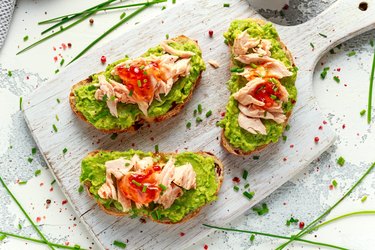There's no question that salt tastes good. After all, when you're following any sort of recipe, it almost always says, "season with salt, to taste" — because if something tastes off, you probably need another dash of salt.
Sodium is an important electrolyte that helps keep your nerves and muscles working properly and maintains the right balance of fluids in your body, according to the U.S. National Library of Medicine.
Video of the Day
Video of the Day
How Much Sodium Per Day?
The American Heart Association (AHA) recommends adults without heart or blood pressure concerns keep their daily intake to 2,300 milligrams (just one teaspoon) and folks with health issues stick to 1,500 milligrams or less.
But Americans actually get an average of 3,400 milligrams per day. Most of this excess sodium, by the way, comes from packaged and processed foods — not from home-cooked meals or using the salt shaker too often.
Eating too much sodium can put you at risk for a host of health problems, including kidney disease, stroke, high blood pressure, osteoporosis, stomach cancer, headaches and kidney and heart failure, according to the AHA. It can also cause you to look bloated because salt holds onto water.
Read on for a list of foods high in sodium. Note that the FDA's Daily Value (DV) percentages are based on eating 2,300 milligrams of sodium per day.
Tip
Read nutrition labels on packaged items and try to choose foods that are low in sodium. Foods with fewer than 140 milligrams per serving are considered low-sodium, per the University of California San Francisco Health.
1. Table Salt: 2,325.5 mg, 97% Daily Value (DV)
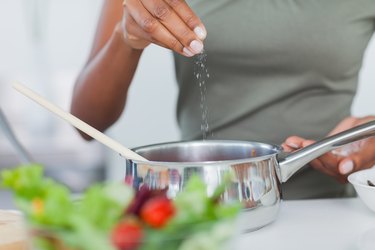
OK, yes, salt is high in sodium because that's what it is. Per 1 teaspoon, salt contains 97 percent of the DV — just about all of your daily limit. But usually, people don't dump a full teaspoon of salt on their food.
If you must season your food with extra salt, try sea salt — it isn't lower in sodium, but the chunks are larger than finely ground table salt, so you'll likely use less.
Alternatively, try seasoning your food with sodium-free spices, including garlic powder, turmeric, ginger, curry powder or paprika.
2. Turkey Sub Sandwich: 1,939 mg, 81% DV
Submarine sandwiches (aka "subs") are the perfect storm for sodium: They have processed meat, processed cheese, condiments and processed bread. A 6-inch sandwich can have 81 percent of the DV for sodium, and double if you order the full size.
But sandwiches can be a healthy lunch with the right adjustments. For example, choose grilled or roasted turkey or chicken instead of cold cuts, use oil and vinegar as condiments instead of mayo and hold the cheese and top with fresh veggies instead. These swaps still contain some sodium, naturally, but not nearly as much as processed foods.
3. Salami: 1,921 mg, 80% DV
The process of curing (preserving) meat requires a lot of salt. That means cured meat like salami has through-the-roof sodium levels. A 3-ounce serving of salami contains 80 percent of the DV, and because salami is often paired with cheese — another high-sodium food — you'll be well over your daily limit with this snack or lunch.
Cured and processed meats should be limited in general due to their sodium levels and because they're associated with higher levels of colon cancer, per the World Cancer Research Fund.
Instead of salami and other cold cuts, opt for fresh cuts of meat or, when possible, choose no-sodium-added meats.
4. Soy Sauce: 1,757.8 mg 73% DV
It's probably no surprise that just 2 tablespoons contain 73 percent of the DV for sodium. Soy sauce is salty. And that's because it's needed for the fermentation process in making soy sauce, according to the Institute of Medicine Committee on Strategies to Reduce Sodium Intake.
Often, soy sauce is available in low- or reduced-sodium varieties, which are better even if not perfect. A 2-tablespoon serving of reduced-sodium soy sauce contains 43 percent of the DV for sodium.
5. Salted Sunflower Seeds: 1,706.3 mg, 71% DV
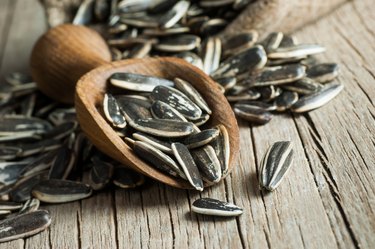
Sunflower seeds are probably better for you than they are not good for you, thanks to their high levels of vitamin E, a powerful antioxidant. And naturally, sunflower seeds aren't high in sodium. But when it comes to the salted variety, a 1-ounce serving contains 70 percent of the DV for sodium.
To cut back on this added sodium, choose the unsalted variety (2.5 milligrams of sodium per 1-ounce serving).
6. Frozen Pizza: 1,273.7 mg, 53% DV
Like most packaged foods, the amount of sodium varies among brands and serving sizes. But frozen foods tend to be incredibly high in sodium to keep them shelf-stable.
Just one slice of a frozen cheese pizza — if you cut the pie into quarters versus sixths or eighths — can clock in at 53 percent of the DV for sodium. When you choose pies that include meat, like pepperoni, your numbers will be even higher. That's why pizza is one of the AHA's six salty foods.
Instead, make your own pizza: Buy large dough from a local pizza place and use your own sauce, cheese and vegetable toppings. Or, opt for a frozen cheese pizza, and add fresh veggies and fill up on a salad to cut back on sodium.
7. Sausage: 902.7mg, 38% DV
Just one link of kielbasa sausage contains 161 percent of your sodium DV. Sausage is also incredibly high in saturated fat — 35 grams per link.
That doesn't mean you can never have sausage. Kielbasa tends to be a larger cut of meat, which means more sodium, thanks to the curing process. Instead, try turkey sausage, which is still processed and contains sodium, but per two links, you'll get just 260 milligrams of sodium or 11 percent of the DV.
8. Canned Baked Beans: 871.2 mg, 36% DV
Anything canned tends to have high levels of sodium because it's used as a preservative. Canned baked beans, for example, contain 36 percent of the DV for sodium per 1-cup serving.
Beans are not naturally high in sodium, which is why using dry beans is a better no- to low-sodium option.
9. Canned Soup: 846.7 mg, 35% DV
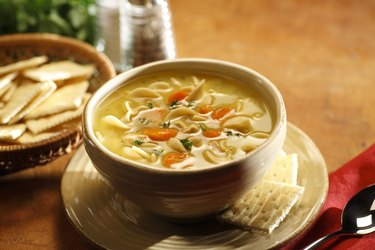
Canned or boxed soups are convenient, yes. But pre-made soups, while often deemed healthy, are high in sodium, which serves as a preservative. A 1-cup serving of canned soup comes with roughly 35 percent of the DV for sodium, depending on the variety. And if you're enjoying the entire can, you might be doubling that.
Instead, find lower-sodium varieties, or add water and your own pasta or veggies to, say, just half a serving of canned soup. That way, you'll cut back on sodium but not on nutrition.
10. Canned Vegetables: 720 mg, 30% DV
You know by now that anything preserved contains high levels of sodium because salt is required for preservation and canned veggies are no exception. Canned vegetables high in sodium, like peas and carrots, can contain 30 percent of the DV per cup.
That said, there are low-sodium options, but it's also important to recognize that for some people, canned produce is the only option due to price restrictions and availability — and eating canned veggies is way better than eating none at all.
Draining canned vegetables reduces sodium content by 36 percent, and draining plus rinsing reduces sodium by 41 percent, per the Produce for Better Health Foundation.
11. Jerky: 670 mg, 28% DV

Jerky, whether that's beef, turkey or even salmon, is a favorite protein-rich, low-carb snack. Thanks to the curing process, it's also very high in sodium: 1 ounce gives you 28 percent of the DV.
It is possible, though, to make your own low-sodium jerky with little to no added salt. (Remember, salt is used primarily to preserve the meat and keep it shelf-stable.)
12. Vegetable Juice: 640 mg, 28% DV
Unless you're making a smoothie at home where you can control the ingredients, drinking your fruits or vegetables means you're probably getting a lot of added sugar and sodium. For example, a 1-cup serving of V8 Original contains 28 percent of the DV for sodium.
Your best bet to keep your sodium numbers in check is to make your own or choose a low-sodium variety.
13. Teriyaki Sauce: 640.1 mg, 27% DV
If something adds flavor and it comes in a package or bottle, chances are it's high in sodium. Teriyaki sauce, a favorite sushi topper and marinade ingredient, packs of 27 percent of the DV for sodium per 2-tablespoon serving. That count is even higher when teriyaki sauce is paired with soy sauce.
There are low-sodium teriyaki sauce options that contain significantly less salt, which can be an easy way to cut back.
14. Broth: 654.2 mg, 27% DV
Broths — veggie, chicken, pork or beef — are a staple in dishes like soups and slow cooker meals. But broths are also notoriously high in sodium — 1 cup of veggie broth contains 27 percent of the DV. Beef broth is comparable, with 27 percent of the DV for sodium per cup.
Most brands offer low-sodium options — and if you're feeling ambitious, you can make your own broth. Pro tip: Don't add more salt to the bouillon cubes.
15. Bacon: 606.2 mg, 25% DV
Bacon is a cured meat, so it's going to be high in sodium. Three slices, slightly more than 1 ounce, contain 25 percent of the DV for sodium. Bacon, while delicious, is also high in not-so-good-for-you fat, making it a food to enjoy in moderation.
There are lower-salt bacon varieties, and skipping added salt on your eggs is another way to cut back on sodium.
16. Pasta Sauce: 576.8 mg, 24% DV
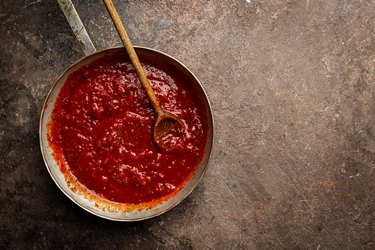
Pasta sauce is one of those sneaky sources of added sugar and sodium. A 1/2-cup serving, likely what you'll pour onto a mound of spaghetti, contains 24 percent of the DV for sodium.
Choose sauces that are lower in sodium or cut back on the amount you add to your meal. Add olive oil, a good source of heart-healthy fat, and seasonings like oregano and basil, for flavor without the excess sodium. You can also make your own tomato pasta sauce and limit the amount of added salt.
17. Smoked Salmon: 571.2 mg, 24% DV
Smoked foods like smoked salmon are high in sodium thanks to the smoking process. Fish on its own is not high in salt. A 3-ounce serving of smoked salmon, a favorite atop bagels, contains 24 percent of the DV for sodium.
You won't find low-sodium smoked salmon, but you can reduce portion sizes and serve on half a bagel instead of a whole one.
18. Cottage Cheese: 539.4 mg, 22% DV
Cottage cheese is an excellent source of calcium and protein. But it also tends to be high in sodium, with 22 percent of the DV per 1-cup serving.
Try no-salt-added varieties (but note that salt is needed for flavor, texture and preservation, so you'd be hard-pressed to find zero-salt cottage cheese).
Flavored or fruit-blended cottage cheese also tends to be high in added sugar, so it's best to go with plain and mix in your own fresh fruit and nuts or seeds.
19. Clams: 510.9 mg, 21% DV
Before you ditch seafood forever, you're right, seafood does provide high-quality nutrition, including lean protein and vitamin B12.
But shellfish (versus finfish) are one of the top foods naturally high in sodium, per Harvard Health Publishing. A 3-ounce serving of raw clams contains 21 percent of the DV for sodium. And that's before you, say, fry them up in a batter.
If your sodium consumption is a concern, choose finfish like omega-3-rich salmon for all the benefits of seafood without the extra salt.
20. Boxed Macaroni and Cheese: 476 mg, 20% DV
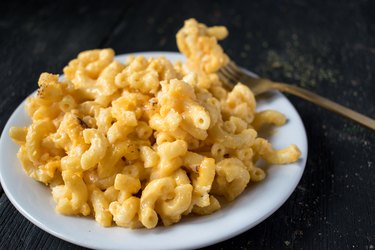
Convenience comes with a cost: Boxed dinners, like macaroni and cheese with packaged cheese sauce, are high in all sorts of preservatives, including sodium. A 1-cup serving contains 20 percent of the DV, and most boxes contain more than two servings, which means sodium adds up quickly.
To cut back on added sodium, choose reduced- or low-sodium varieties when possible and limit your intake of boxed meals.
21. American Cheese: 467.9 mg, 19% DV
It's hard to find more processed cheese than American cheese. Just one slice (slightly less than a 1-ounce serving) contains 19 percent of the DV for sodium. Top that on your sliced cold-cut sandwich with condiments and white bread and you're in for a sodium bomb.
Instead, try cheeses that are less processed like cheddar, which contains just 8 percent of the DV for sodium per 1-ounce serving, or a single slice.
22. Bagels: 443.1 mg, 18% DV
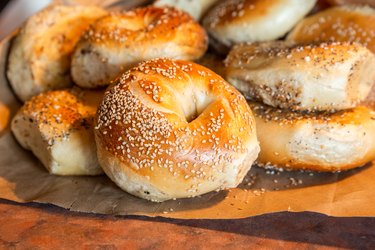
Like certain breads, bagels contain more sodium than you may realize — and that's before you factor in everything or, er, salt, toppings. One medium-sized bagel contains 18 percent of the DV for sodium, and if you've ever eaten a bagel, most are on the very large size (with around 23 percent of the DV for sodium).
Watch your portions and try unsalted butter or unsalted peanut butter for your spreads instead of sodium-heavy cream cheese.
23. Tortilla Wraps: 380 mg, 16% DV
The next time you prepare soft tacos or a cheese quesadilla, think twice about your tortilla. A single flour tortilla contains 16 percent of the DV for sodium, and if you're like us, you don't stop at just one. Add in cheese and sauce, and your sodium numbers start to skyrocket.
Corn tortillas tend to be smaller with little to no sodium, making them a better (and more authentic) choice.
24. Cereal Bars: 354 mg, 15% DV
Once again, convenient packaged snacks make it easy to eat more sodium and sugar than you realize. A single cereal bar, for example, contains about 15 percent of the DV for sodium and 59 (!) percent of the DV for sugar.
Be sure to read the labels for lower sodium options on snack bars.
25. Pretzels: 352.2 mg, 15% DV

Pretzels wouldn't really be pretzels without those large crystals added to the outsides of each twist. But a 1-ounce serving has 15 percent of the DV for sodium, making them, well, a salty snack. And while you could opt for the unsalted variety, those wouldn't really be the same, would they?
Halve the serving size and pair with a piece of fruit so you don't have to miss out on your favorite snack. The fruit will add fiber and antioxidants for a well-rounded nosh.
26. Salad Dressing: 307.9 mg, 13% DV
Like sauces, packaged salad dressings can add sodium to your dishes. A 2-tablespoon serving contains roughly 13 percent of the DV for sodium, with some fluctuation based on flavor.
To cut back on added sodium in salad dressings, reach for low-sodium options, make your own or try tossing your salad with a little olive oil and vinegar.
27. Bread: 284.2 mg, 12% DV
Bread can be a sneaky source of added sodium, especially packaged breads. Two slices of white bread, for example, contain 12 percent of the DV.
When shopping for packaged bread, be sure to read the labels; sprouted-grain breads tend to be lower in sodium. It's also important to consider other health benefits of your bread choice: Opt for whole-grain options, which provide fiber, and avoid ones with added sugar.
28. Pork Rinds: 283.5 mg, 12% DV
If pork rinds (deep-fried pigskin) are your jam, know that they have high levels of fat, particularly saturated fat, and sodium. A 1-ounce serving contains 12 percent of the DV for sodium. Pork rinds are, however, high in protein, with 18 grams per 1-ounce serving.
Instead of the rinds, try unsalted nuts or halve your pork rind serving size.
29. Pickles: 283.2 mg, 12% DV

In order to make a pickle, you need a lot of salt. That's what brining is, after all. One small Dill pickle spear contains 12 percent of the DV for sodium, making pickles a favorite for athletes to replenish electrolytes.
You can't remove salt from pickles thanks to the brining process, so keep your portion sizes in check to cut back on sodium.
30. Potato Chips: 147.6 mg, 6% DV
Looks can be deceiving: A serving of potato chips, about 15 chips, contains "only" 6 percent of the DV for sodium. So you're probably thinking, why are chips notorious for being salt bombs?
It's all about the serving size: Chances are, you're eating more than one serving of chips. A large-size bag, for example, contains 18 percent of the DV for sodium, and some brands use more salt than others.
Your best bet to keep your sodium in check while snacking is to watch your serving sizes — you'll still satisfy your salt craving — and mixing up your favorite snacks with lower-sodium options like fresh fruit and vegetables.
The Bottom Line
Generally, the top sodium-rich foods include:
- Proteins that are smoked, cured, salted and canned (such as deli meat, bacon, smoked salmon, jerky, hot dogs and sausage)
- Frozen or processed dinners (such as boxed mac and cheese)
- Restaurant meals
- Some canned foods (including canned vegetables and soups)
- Soy sauce
- Broth
To cut back on salt, opt for fresh whole foods that are minimally processed and try to cook at home as much as possible.
- U.S. National Library of Medicine: "Sodium"
- American Heart Association: "Effects of Excess Sodium Infographic"
- World Cancer Reserach Fund: "Limit Red and Processed Meats"
- Harvard Health Publishing: "Eat Seafood the Healthy Way"
- U.S. Institute of Medicine: "Strategies to Reduce Sodium Intake"
- Institute of Food Technologists: "Sodium Reduction in Canned Bean Varieties by Draining and Rinsing"
- University of California San Francisco: "Guidelines for a Low Sodium Diet"

